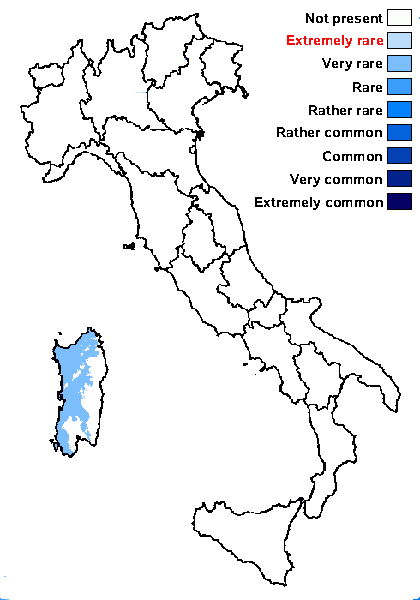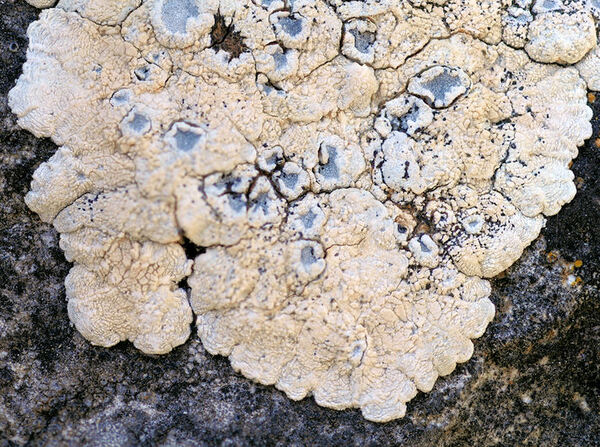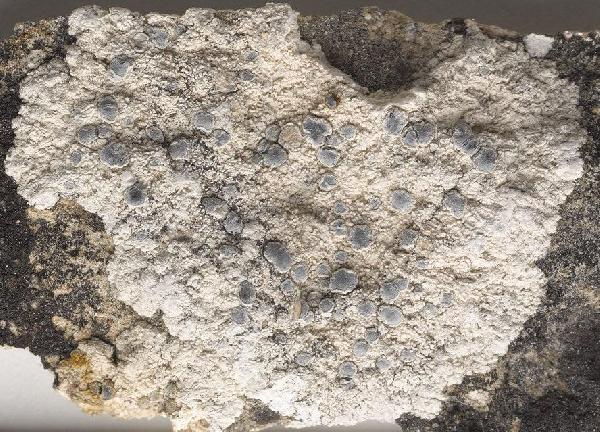Lobothallia cernohorskyana (Clauzade & Vězda) A. Nordin, Cl. Roux & Sohrabi
in Roux, Bull. Soc. linn. Provence, num. spéc. 16: 216, 2012. Basionym: Lecanora cernohorskyana Clauzade & Vězda - Preslia 42, 3: 216, 1970.
Synonyms: Aspicilia cernohorskyana (Clauzade & Vězda) Cl. Roux
Distribution: C - Sar (ASU-506831).
Description: Thallus crustose-subleprose, episubstratic, up to 4 cm wide, c. 0.5 mm thick, chalky white, continuous or rarely cracked, with an irregular, markedly papillose surface (the papillae resembling isidia), the margins often indistinctly lobed, giving the thallus a subplacodioid appearance. Cortex of anticlinally arranged hyphae, containing crystals visible under polarized light; algal layer irregular; medulla thick, white, lax, filled with crystals. Apothecia lecanorine-aspicilioid, at first immersed in the thallus, then clearly sessile, round or irregular in outline, 0.7-1.5 mm across, with a concave to finally flat, blue-grey-pruinose disc and a thin, but evident thalline margin. Epithecium 2-layered, the upper layer grey, consisting of crystals (pruina) the lower layer brownish green, N-; hymenium colourless, c. 100 µm high, I+ blue then reddish; paraphyses sparingly branched and anastomosing, strongly coherent, 2-2.5 µm thick, the apical cells only slightly swollen; hypothecium colourless, devoid of crystals, subtended by an algal layer. Asci 8-spored, cylindrical-clavate, the thin outer coat K/I+ blue, the wall and apical dome K/I-. Ascospores 1-celled, hyaline, broadly ellipsoid, (8-)11-15(-18) x (5-)7-10(-12) µm, the wall 0.5-1 µm thick. Photobiont chlorococcoid. Spot tests: cortex of thallus and medulla K- C-, KC-, P-; medulla of apothecial margin and hypothecium K+ yellow turning red (needle-like crystals), P+ yellow. Chemistry: cortex of thallus without lichen substances, apothecial margin and hypothecium with norstictic acid.Note: a mainly Mediterranean species growing on soft, porous calcareous marls in sunny situations.
Growth form: Crustose
Substrata: rocks
Photobiont: green algae other than Trentepohlia
Reproductive strategy: mainly sexual
Commonnes-rarity: (info)
Alpine belt: absent
Subalpine belt: absent
Oromediterranean belt: absent
Montane belt: absent
Submediterranean belt: absent
Padanian area: absent
Humid submediterranean belt: very rare
Humid mediterranean belt: very rare
Dry mediterranean belt: absent

Predictive model

Einar Timdal - Source: http://www.nhm2.uio.no/botanisk/lav/Photo_Gallery/Aspicilia/cernohorskyana_G=Greece+Crete_D=20090529_O=E-Timdal_C=ET_H=O-L156012_I=DSC10234-53.JPG

Einar Timdal - Source: http://www.nhm2.uio.no/botanisk/lav/Photo_Gallery/Aspicilia/cernohorskyana_G=Greece+Crete_D=20090529_O=E-Timdal_C=ET_H=O-L156012_I=DSC10234-53.JPG

Modified from the original at: https://gzu.jacq.org/GZU000291030
GZU 000291030 -Collector Clauzade,G. s.n.
Date 1968-04-15
Location France / Provence-Alpes-Côte d'Azur
Label France, Vaucluse, Gordes, entre les Dilais et la Rouguiere ; Alt. 350 m
Habitat Pente E du toit d´une borie (cabane en pierres sectres), sur delta de molasse inframiocene legerement inclinee vers l´E
Habitus
Annotations GZU Inv.-Nr. 269-81
á amphithecium K+ (rouge) et spores souvent dilatees á une extremité
Growth form: Crustose
Substrata: rocks
Photobiont: green algae other than Trentepohlia
Reproductive strategy: mainly sexual
Commonnes-rarity: (info)
Alpine belt: absent
Subalpine belt: absent
Oromediterranean belt: absent
Montane belt: absent
Submediterranean belt: absent
Padanian area: absent
Humid submediterranean belt: very rare
Humid mediterranean belt: very rare
Dry mediterranean belt: absent

Predictive model

Einar Timdal - Source: http://www.nhm2.uio.no/botanisk/lav/Photo_Gallery/Aspicilia/cernohorskyana_G=Greece+Crete_D=20090529_O=E-Timdal_C=ET_H=O-L156012_I=DSC10234-53.JPG

Einar Timdal - Source: http://www.nhm2.uio.no/botanisk/lav/Photo_Gallery/Aspicilia/cernohorskyana_G=Greece+Crete_D=20090529_O=E-Timdal_C=ET_H=O-L156012_I=DSC10234-53.JPG

 Index Fungorum
Index Fungorum
 GBIF
GBIF

